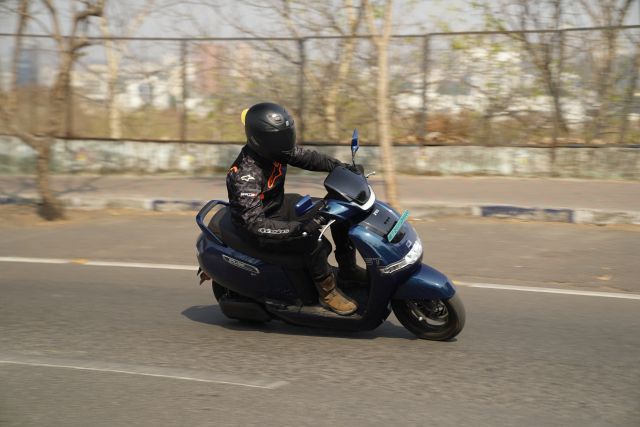
The TVS iQube ST 5.1-kWh promises an impressive range figure and improved practicality, but is the steep price worth it?
The announcement about the TVS iQube series launch was in May 2022: the base, the S, as well as the ST. While we have ridden the base and the S over the years gone by, the top-of-the-line ST variant had been MIA since then. Fortunately, this month we finally received the iQube ST in its high-capacity 5.1-kWh avatar. The delay in this scooter’s arrival has been significant but, as they say, better late than never.
With regard to design, it’s largely the same story as the other iQubes, the key differentiating factors being the new colours. The starlight blue scooter we received looked spectacular. In case you’re wondering, yes, the swing-arm still has the glowing-blue “electric” lettering which I find quite cool but far too bright.
The foldable pillion foot-rest sticks too far out from the scooter and makes reaching the centre-stand with one’s foot harder than it needs to be. It also makes the iQube much more prone to getting nudged in traffic by other two-wheelers.
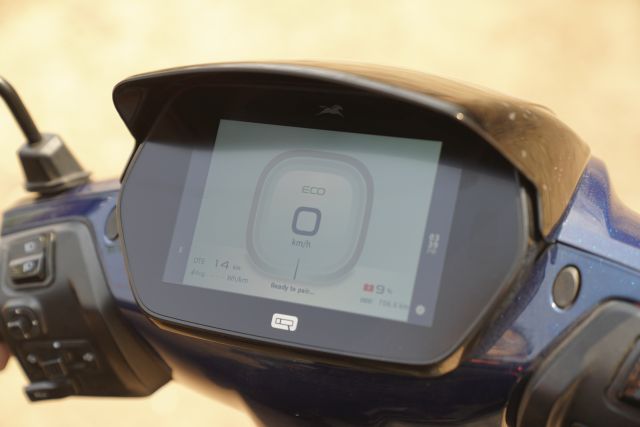
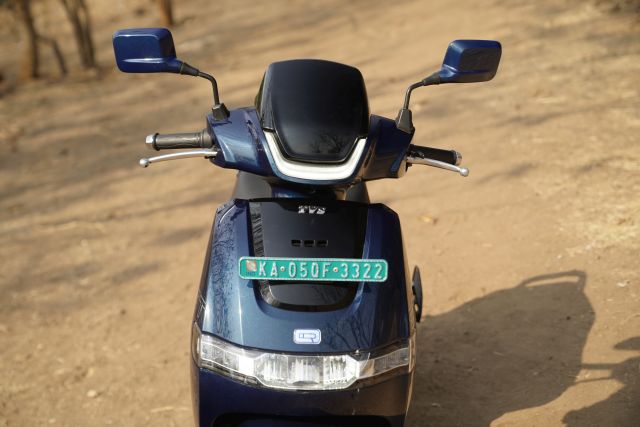
The seven-inch touchscreen TFT has a host of connected tech, TPMS as well as a few different display modes. I found the standard one the best since the analogue mode looked like a third-party software skin and the custom colour/wallpaper modes felt unnecessary and a waste of screen space. The animations are also slightly glitchy regardless of what mode you’re in. When accelerating, a progress bar or needle (depending on display mode) climbs upwards and when you release the throttle and the scooter begins regenerative braking, there’s a rapidly recurring animation of the progress bar moving back down. This display transition between acceleration and regen isn’t exactly seamless and can flicker or make the whole on-screen graphic display disappear for a split second. Needless to say, this takes away from the overall software experience.
Under-seat storage is impressive at 32 litres and while the cavity isn’t deep enough for a full-sized full-face helmet, it is long and spacious enough to be more than adequate for anything else. This, paired with a reasonably large footboard, means you’re all set on the storage front.
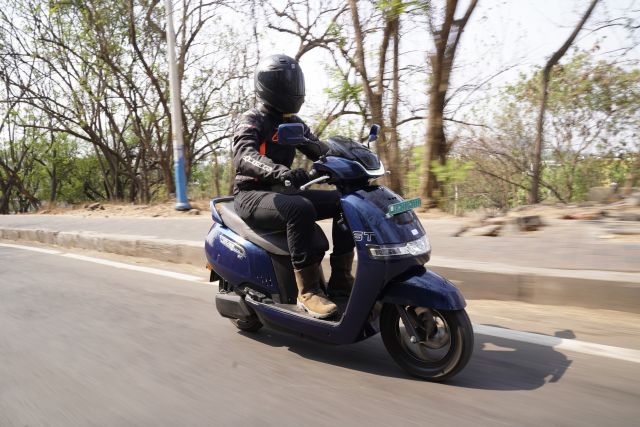
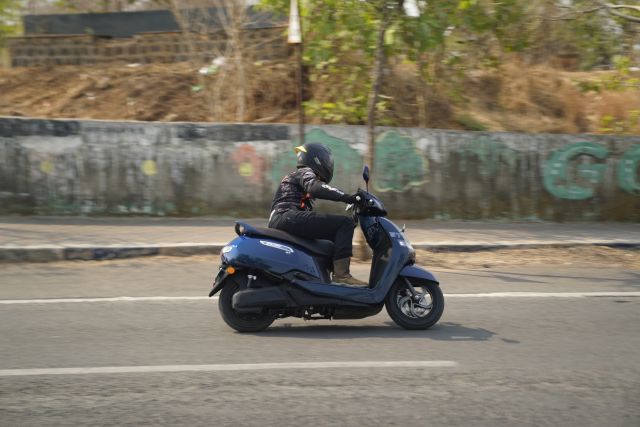
The iQube ST has a lithium-ion battery and hub-mounted motor, both with IP67 water and dust resistance. Peak power is 4.4 kW (six hp) and peak torque is rated at 140 Nm. Both these figures are identical across all five variants in the iQube range, regardless of battery sizes.
TVS claim a real-world range of 150 kilometres and 0-80 per cent charge time of four hours and 18 minutes, supported by 950-W charging. I tested the range of the iQube exclusively in Eco mode and got 124 km of total range, 26 km less than what TVS claim; still an impressive figure.
There are two riding modes, eco and power (displayed as ECO and PWR), whose primary differentiating factors are throttle response, top speed, and, of course, range. There’s a minor input lag in eco, which remains noticeable but significantly reduced in power mode. Power mode also has a sharper throttle overall and isn’t electronically limited to 55 km/h as eco is, so you can cross 80 km/h here. The same button that’s used to arm the motor while setting off is also the mode-change button, which can be used to quickly toggle between eco and power on the go.
The second I started riding the iQube ST, it immediately became clear that despite the large battery capacity, this is still very much the comfortable family scooter it has always been. It does not intend to cater to spirited riding at all and makes for a very well-rounded experience of what its intended purpose is. The throttle set-up is linear and progressive and even in power mode, the iQube ST feels quick but not sporty. The suspension set-up only adds to the scooter’s overall composure; small to medium road irregularities at low to moderate speeds are absorbed very well and even larger bumps are tackled without fuss. I found this to be a good suspension set-up that I’d almost call relaxing at city speeds. The faster you go, though, the more you start to feel what’s going on under the tyres. The handling, again, isn’t sharp but it’s precise enough for this type of scooter and does a decent job of masking the iQube ST’s hefty 132-kilogram weight.

I often conduct a simple test to determine how relaxing a vehicle makes me feel while riding or driving it. Our testing vehicles are parked at our office garage, so once work is over for the day, I take the vehicle and go straight to the gym as I always do. After gym, I usually feel very tired and the nearly eight-km-long journey home seems like a bit of a task. Fun, fast, and sharp vehicles sometimes feel overly eager during this time and while I’d usually enjoy them, I like to chill and wind down a little with a more calm ride after a tiring day. The iQube ST checks this box perfectly. Its composed and linear nature made my evening commute relaxing and stress-free. By the time I reached home, I would feel a little more rested than when I had left. That’s a good sign for sure.
By now you must have inferred that I like the TVS iQube ST. It’s probably one of the best electric scooters I’ve ridden in a while and that’s largely because of the consistency in its character. It knows what it wants to be and it does that well. However, as with most things, there’s a problem. The TVS iQube ST with the 5.1-kWh battery pack costs Rs 1.85 lakh (ex-showroom). That’s a sizeable amount to pay for an electric scooter even if it does have a very promising real-world range figure. It costs Rs 48,000 more than the Ather Rizta Z with the 3.7-kWh battery pack and a claimed IDC range of 159 km.
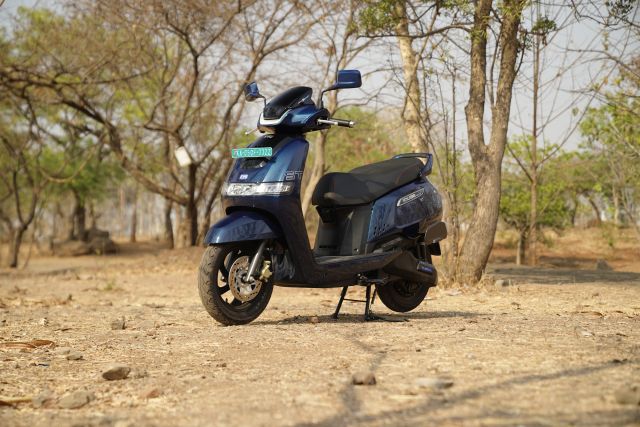
The iQube is an extremely likeable scooter and there’s a fair chance that if you test-ride it, you’ll want one, but in this ST variant with the 5.1-kWh battery pack, it’s simply too expensive. My suggestion to prospective buyers would be to first analyse your day-to-day scooter use and figure out how much range you really need. Chances are you’ll be able to get by just fine with the 3.4-kWh iQube ST or even one of the lower non-ST variants. In doing so, you’ll save a substantial amount of money and get identical performance figures and a lower weight too. If you do need the extra range and are keen on getting an iQube, I still maintain that this is a very capable scooter, but in that case the price tag is something you will have to come to terms with.
Also read: Aprilia Tuono 457 Review


Leave a Reply